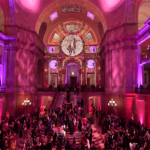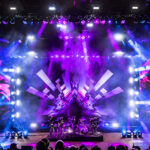Video mapping projects — beyond the LED concert video wall — have become more commonplace over recent years. They’re part of our landscape, adding images everywhere in our environment. While advances in technology have made these projects more feasible, challenges are still there. PLSN took a below-the-surface look at two recent projects to discover what confronts projecting on a creative palette beyond the screen.

Projection Art on an Art Museum
The projection palette for Brussels, Belgium-based Visual Solutions featured the exterior of the Doha Museum of Islamic Art in Qatar. The April 7 party launched Vogue magazine’s new Middle Eastern edition, Vogue Arabia, with projection mapping that served as the event backdrop.
VER Europe provided projection equipment, including the main components of 21 Barco HDF-W30 projectors run by four d3 media servers.
Jo Pauly of Visual Solutions details the myriad of challenges of this event, which would entertain 200 guests — including Qatar’s royal family — for dinner and a show by Lauryn Hill in the courtyard.
With just three weeks’ notice, Visual Solutions was asked to map the museum with images at 138 x 138 feet (42m x 42m), at a height of 79 feet (24m).
“When technical director Ludo Vanstreels (of Trimex) asked me to take a look at his exciting project, I knew it was going to be a challenge, but with the right partners and tools, it was going to be a piece of cake,” Pauly says. The team simulated the projector setup from a 3D model of the museum, which they found on the Google SketchUp 3D Warehouse website. Though they couldn’t trust the model for accuracy, it did give them the right ratio and basic building specs.
Then, during a site visit, the team re-measured and compiled a 3D scan of the building using 1,250 high res pictures. They now had an accurate 3D model of the building, so preproduction of content could begin. And from there, they could showcase to the clients how the content created for this event would look without even being on site.
“The client wanted to do a full 360-degrees projection with a very powerful light output. We chose to use our media servers of choice: d3 pro 4×4 VFC range. And we chose to use the most powerful, compact and reliable projector around: the Barco HDF-W30.”
The projector setup plan was pre-visualized in d3 from Visual Solutions’ office in Brussels. “We were able to perfectly define projector positions, shadow casts and predict the light output and difficulties from props standing between the beam and the projection surfaces in the venue.”
Pauly chose to have a “comfortable amount” of +-250 lux on the building, noting that the building’s yellow-tinted limestone enhanced the palette for projection.
Physical challenges came from the high daytime temperatures, humidity, and the sea breeze, which forced the team to consider counter measures to ensure proper working of the projectors. For protection, the team constructed top covers out of StageDex to shield projectors from direct sunlight, and placed a big fan behind each unit to maximize cooling airflow.
“It worked like a charm. There was not one projector that flinched or suffered from the heat,” he says.
Projectors were installed on the museum’s rooftop, most projecting straight to the building, while a few of them had to cross shoot to avoid a small structure in the center of the courtyard.
Along with the close monitoring on the projectors, they benefited from having projection maintenance engineer Benjamin “Benny” Oehl from VER Frankfurt on the team, with the whole project followed by account manager Nils Pauwels of VER.
“It’s a pleasure to work with Jo Pauly,” says Pauwels. “His skills, knowledge and work ethic are second to none. After many successful productions, we look forward to further strengthening our partnership in the future.”

Projection Art and Ads on Ice
Moo TV’s projection palette is a 200-by-80 foot layer of ice. Moo TV works with ice hockey team the Nashville Predators, currently in the NHL Playoffs at Bridgestone Arena. The Preds commissioned Moo TV to create ice projections to excite the crowds until either they win the Stanley Cup or get knocked out of the running.
Apparently, the projections are working — as the team has advanced to play their first Stanley Cup Final in the franchise’s history, starting May 29.
So while the fans in the stands now arrive energized, the projections are designed to keep the fire burning in the chilled environment during a few key segments: to spark energy during the pre-game intro and opening festivities; to rouse the crowd during a celebrity singing of the National Anthem; and to excite the night during period intermissions. The ice also serves as digital signage for the sponsors, and enables the venue to easily take on more advertisers as the Preds advance in the competition.
Main components of the gear list include eight Barco HDF-W30 Projectors; two Christie Pandoras Box Manager Servers and two Christie Pandoras Box Playout Servers. The required tactical fiber optic cable spans three-quarters of a mile at 4,000 feet, while power cable reaches over one mile at 5,500 feet.
Moo TV general manager Devin Cundall says the sponsored content changes with every game, the highlight of which is the realtime Zamboni tracking, in which the machines reveal the sponsor logos as they refresh the ice.

While light can reflect on the ice, the surface is actually an “acceptable palette,” Cundall explains. “There’s some light scatter due to the ice itself, but it mostly manifests itself in a slightly softer focus and a wonderful surreal glow, if you are on the ice itself. As we are projecting straight down, the angle of reflectance is about the same for everyone in the arena.”
One of the biggest challenges is rigging the eight Barco projectors where they need them. “As with any projection show, we want to avoid short throw lenses for optimal brightness and consistency, but that requires added throw distance. Every building presents its own challenges, and Bridgestone’s is that the grid is actually sloped, so on one side of the rink we have about six feet more throw distance than the other, which can make a world of difference. Added to that, the Megatron in the center of the arena — which we need to shoot under cleanly — trims lower than most arenas, making projector placement and optimized beam angles critical.”
And with Bridgestone Arena’s busy schedule — with concerts often wedged between game days — Moo TV needs to do some “creative rigging” to ensure that projector placement can remain in place without impeding the building’s normal operations.
Moo TV chose Barco projectors for several reasons. “The solution fit like a glove for this arena environment. We needed items like remote monitoring of the projectors, control over lens throw angle, and lots of flexibility,” he says. “This is an incredibly difficult setup with unique structures in the way, like the giant Megatron.”
They selected Christie Pandoras Box media servers and content manager for similar flexibility reasons. “Going in to this, even we didn’t know all the variables. A quick example: if we were controlling the lights or if game operations were going to control the lights, Pandora gives us lots of flexibility and tons of control. This solution also has a robust tracking solution needed for Zamboni elements of the show.”
Moo’s content division, Moo Creative Media, generates the digital content, from displays of player’s stats to sponsor logos and images designed to stimulate fan spirit. And yet content poses another big challenge, Cundall says.
“We need to build content for the entire bowl, while knowing the viewership extends beyond to YouTube and social media,” he explains. “This means finding a balance between force perspective/faux 3D effects that employ a sense of depth and play well on small screens, but whose effects can only be perceived by a small portion of the crowd, and flatter elements that are immediately perceptible to everyone in the crowd, but don’t feel as impressive if you aren’t in the space where the sheer size of the palette lends magnitude to the content.
“To find this balance, we’ll rotate the palette frequently to shift the optimal viewing angle for 3D elements, and find ways to cater to the often ignored end zones of the bowl by directing content solely at them,” Cundall continues.
The projection displays have created a buzz of good feedback from fans and the facility’s management team alike.
“It’s a cool experience,” Cundall concludes. “The content of this particular round has blown away other hockey teams’ productions.”
As the team edges closer than ever to a Stanley Cup win, the Predators are “super excited that they are on the leading edge of creativity. It has opened their eyes and has them thinking about how to expand on this. It’s been a positive projection project.”


